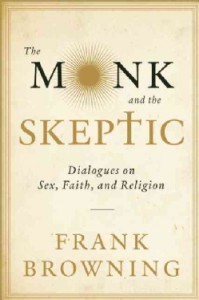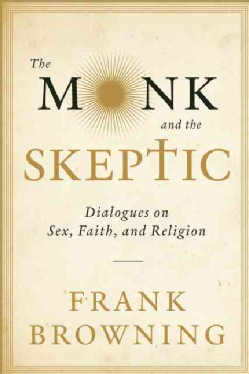 The Monk and the Skeptic: Dialogues
The Monk and the Skeptic: Dialogues
on Sex, Faith and Religion
by Frank Browning
Soft Skull Press. 208 pages, $16.95
A LONGTIME CORRESPONDENT for National Public Radio, Frank Browning is the author of two widely discussed books in the field of gay studies: The Culture of Desire (1993) and A Queer Geography (1996). His explorations of gay history and gay identity have been praised as expansive and provocative, engaging and readable. His latest work, The Monk and the Skeptic: Dialogues on Sex, Faith, and Religion, is all of those things.
While his subject is a sprawling one, Browning’s prose is accessible and concise. This is due in part to his decision to employ the convention of the philosophical dialogue. Like the Socratic dialogues of Plato, Browning’s are lively exchanges of ideas on a series of themes. But unlike Plato’s descriptions of Socrates at work with his students, Browning’s colloquies are framed by encounters between the monk and the skeptic of the book’s title, and they have a homoerotic element. They begin when the narrator cruises a distinguished-looking gentleman at a Pierre et Gilles exhibit in Paris’s Place de la Concorde. The gentleman turns out to be a Dominican monk, dubbed Brother Peter, who’s happy to share his body, as well as his thoughts, with his curious admirer, “the skeptic.” Their relationship, such as it is, progresses along with their intellectual explorations.
By introducing the character of an unashamedly sexual priest, and a homosexual one at that, Browning sets us up for an interesting ride, and he delivers. His discussions are wonderfully peripatetic. This makes it difficult to categorize The Monk and the Skeptic, which covers a vast range of subjects. There are sections devoted to pornography and masturbation, the gay marriage debate, the duties of gay history and scholarship, the San Francisco-based Sisters of Perpetual Indulgence, the virtues of gay motorcycle gangs, and an obscure footnote to the history of the Inquisition involving the 13th-century religious sect known as the Cathars.
Above all, Brother Peter (Browning is indulging in some ribald punning here) has plenty to say about sex, as in the third dialogue, “The Perils of Porn,” which explores the morality of pornography and masturbation. As Peter’s interlocutor observes at the start of this dialogue, the good Dominican’s pronouncements about sex are always informed by his deep reading of great church thinkers like St. Augustine, Karl Barth, and Teilhard de Chardin. One wouldn’t expect those names to come up in a discussion of masturbation (well, okay, maybe Augustine), but Browning makes it all work as he parses out church teaching on whether or not non-procreative sex is a true sin. The dialogue also includes some intriguing tidbits about the biological utility of homosexuality (courtesy of famed biologist E.O. Wilson), as well as research on the health benefits of repeated ejaculation. Browning’s love of esoterica is evident in his digression on the “physiocrats,” an anti-masturbation movement that originated in the 18th century.
As charmingly meandering as Browning’s dialogues can seem, he doesn’t shy away from sustained discussion of timely and important topics. For example, he tackles same-sex marriage in his fifth dialogue, “Sacred & Unholy Unions,” in which Brother Peter makes his position clear: “[T]he objective of marriage in a Christian society must be to recognize a union which, in general, consecrates the continuation of humanity. That is not possible between two men and two women.” The skeptic avoids the urge to “battle the logical lapses, the religious myopia, and the biological confusion” of Brother Peter’s assertions and instead focuses the discussion on calling out the failures of the “marriage campaign launched by the current gay movement.” (The book was published before the arrival of Pope Francis and doesn’t address his recent, intriguing statements about homosexuality.)
There are times when the dialogues’ give-and-take become conspicuously biased in favor of the skeptic, though at other times he sides with the monk. In the marriage discussion, for example, the skeptic gets the last word, and it’s a rather extended monologue. Which is fine: clearly Browning has a point of view to advance, often that of a gadfly, and in this role he is authoritative and entertaining. He includes in the discussion of marriage an account of historian Daniel Mendelsohn’s critique of John Boswell’s 1994 book Same-Sex Unions in Pre-Modern Europe, in which Mendelsohn called gay historians like Boswell to task for letting their biases undermine their scholarly integrity. He seems to side with Mendelsohn, but the larger point is that Boswell’s suspect scholarship provided a false foundation for arguments about same-sex marriage that followed in its wake.
At the skeptic’s prompting, Brother Peter offers up detailed descriptions of his coming-out process, his call to clerical life, and his ongoing effort to reconcile the demands of his sexuality and those of his calling. One wonders if Browning is drawing upon biographical material, either his own or that of a lover or close friend. For all of those who are engaged with these questions of faith and sexuality, The Monk and the Skeptic is a worthy read.
________________________________________________________
Jim Nawrocki is a writer based in San Francisco.






